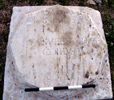Description: Marble panel (original measurements, w:
0.85 x h:
0.85), later cut down to form a base for an octagonal altar
(max width w:
0.77 x h:
0.76).
Text: Inscribed on one face.
Letters: First century CE; line 1, 0.075; lines 2, 3, 0.055; line 4, 0.05; dot for stops; apices above E in line 3 and V, A and the
first o in line 4.
Date: CE 4-14
Findspot:
Cyrene:
Agora, North Stoa; found in 1917.
Original location: Unknown.
Last recorded location:
Findspot (2008).
Interpretive
[T]ị(berius) Ịulius ((stop)) Aug[usti Caesaris filius]
( vac. 1) ((stop)) diui ((stop)) nepos ((stop)) Ca[esaris c. 12]
( vac. 2 lines)
( vac. 1) M(arcus) ((stop)) Sufenas ((stop)) M(arci) ((stop)) f(ilius) ((stop)) P[roculus praef(ectus)?] ( vac. 1)
( vac. 1) coh(ortis) ((stop)) Lusitanorụ[m Cyrenaicae?] ( vac. 1)
Diplomatic
[.]..ULIUS • AUG[..................]
• DIUI • NEPOS • CA[......············]
vacat
M • SUFENAS • M • F • P[............]
COH • LUSITANOR.[...........]
English translation
Translation by: Editors
Tiberius Julius [son of] Aug[ustus Caesar], grandson of deified Ca[esar . . . ] Marcus Sufenas son of Marcus, P[roculus, prefect?]
of the cohort of the Lusitanians [?of Cyrenaica] (scil. honoured him).
Bibliography: L. Gasperini in Gasperini, 1965, 327 and pl. LIX. 7-8; Gasperini, 1967a 173-174, 33, fig. 216; Demougin, 1978, 620, whence AE 1978.830, whence EDH 004639; see most recently Zucca, 2007
Text constituted from: Transcription (Reynolds).
Images
 Fig. 1
Fig. 1. Monument (2008, H.Walda)
 Fig. 2
Fig. 2. Face (Department of Antiquities, E. 496)
 Fig. 3
Fig. 3. Face (2008, H.Walda)
 Fig. 4
Fig. 4. Face (2008, H.Walda)



